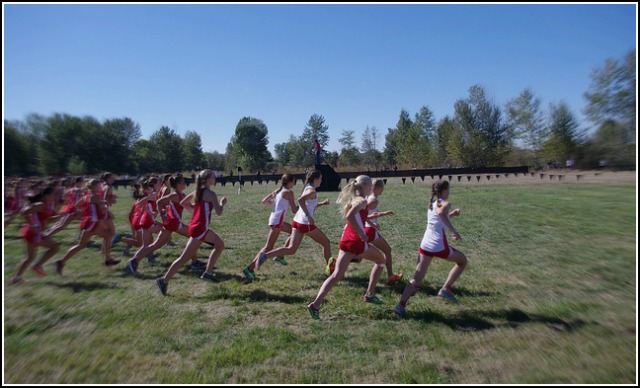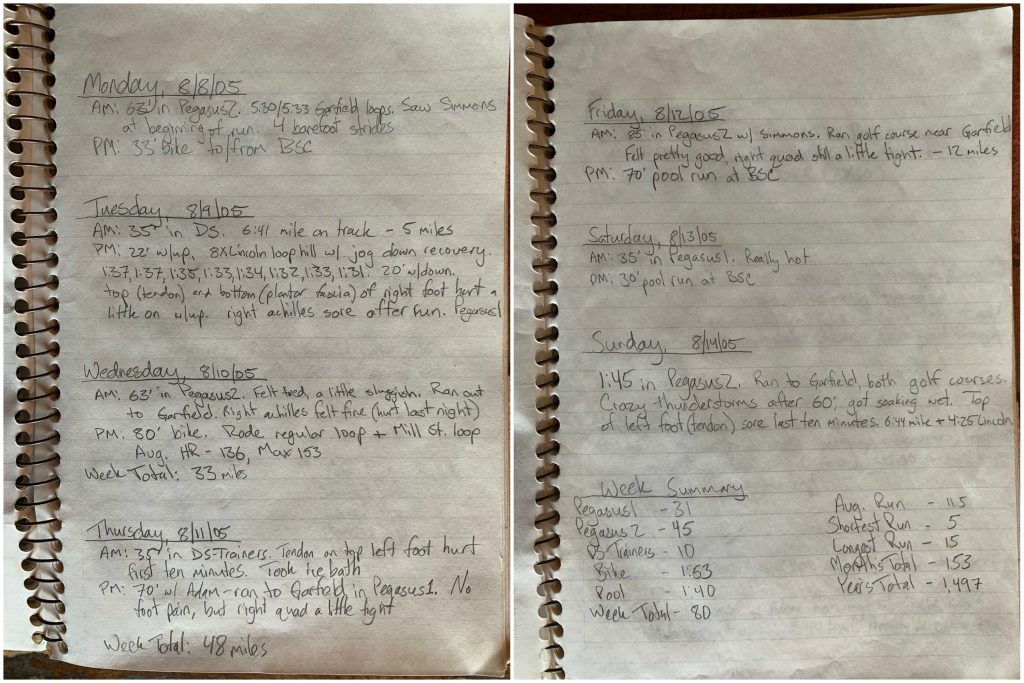Cross country was always my favorite season of running. Sweaty summer miles lead to fast, fall racing. What could be better?

Perhaps my love for cross country is rooted in its team dynamic. It’s a lot more team-oriented than track and field and everyone on the team is a distance runner.
It always felt more cohesive to me. More of a small family. Last year, I even flew across the country to see my cross country coach for his retirement party (we’re cute, aren’t we?). Running is a strong bond.
So when my final collegiate cross country season was approaching in 2005, I wanted to make it my best ever. No more missed opportunities or wasted time due to injuries.
This was going to be my season. My entire summer was dedicated to cross country running.
And I left no stone unturned. I dedicated those months to base training, prioritizing injury prevention and getting in as many miles and hours of cross-training as possible.
It worked: my 8km personal best improved to 26:19 and I won a run-off for the Varsity team’s last spot for the Regional Meet.
Nearly 200 hours of running, a few bouts of throwing up, dozens of hours of cross-training, and more suffering than I care to remember all became worth it. That 2005 season was my most rewarding and 13 years later, I still look back on it fondly.
Today I want to give you a look back on the week of August 8, 2005 – peak base training for my fall cross country season.
Training for XC: Inside My Log
2005 Cross Country: The Season of Big Hair and Shaved Legs
While this summer of training was similar to prior seasons, it was markedly different in a few different ways:
- Consistent barefoot strides and drills as an injury prevention measure 2-3 times per week
- Several hours of cross-training (road cycling and pool running) per week
- More strength training than prior seasons (in hindsight, it was still not enough)
- Earlier weeks included “rollercoaster runs” (discussed here) for strength and injury prevention
These new additions allowed a healthy, injury-free season from June to November. I hadn’t run injury-free for six months in a long time…
Here’s our sample week, from peak training in mid-August:

There’s a lot of jargon and odd notations here, so let me explain:
- I used an average of 7:00 mile-pace to estimate my mileage based on how long I ran. These are Badger Miles
- The single quotation mark should be read as “minutes”
- Pegasus 1, Pegasus 2, and DS Trainers are the names of 3 pairs of shoes that I was running in at the time
- I noted a few timed loops called Lincoln and Garfield. The times don’t mean much, except to show broad trends over time, so you can just ignore them
For me, this was a very typical week of summer cross country training. The priority of the summer was to increase my weekly mileage to 80+ and then stay there and be as consistent as possible.
Looking over this training log, what can we learn? What lessons will help your running, no matter what race you’re training for?
Cross Country Running is Like Life
You get out of cross country what you put into it. Without a big summer of mileage, a fall season doesn’t have the foundation for success.
Knowing that, I poured everything into the summer months of June, July, and August. And there’s lesson #1.
A Foundation is Critical
No matter if you’re training for a 5k or a marathon, a base of fitness is required to run well. That’s why I don’t write “Couch to Marathon” plans.
So if you’re in the “in-between” area between seasons and you’re not sure what to do, build your mileage. You can’t go wrong by running a lot of easy miles to further develop the aerobic metabolism.
It makes any hard work you do in the future much easier (and you more capable)!
Barefoot Running is a Tool
I don’t call myself “Barefoot Jason” for the same reason that I avoid “Long Run Jason” or “Deadlift Jason” or “Fartlek Jason.”
All of these are training tools to help you accomplish a certain task. Just like you wouldn’t run easy every day, or deadlift every day, or run a fast workout every day, you certainly shouldn’t be running barefoot every day.
In this monster barefoot running post, you can see the benefits of running without shoes and how to do it effectively for maximum gains.
Cross-Training is Undervalued
Runners want to run, that’s for sure! I’d rather have run 100+ weekly miles than supplement my running with cycling and pool running.
Alas, I was too injury-prone for that. So I opted for the next best thing: cross-training.
Most runners would see dramatic improvement if they strategically used cross-training to increase their endurance and recovery. That’s because there are barely any drawbacks! It’s a lot of gain, for very few downsides…
I wrote previously about “Performance Multipliers” and cross-training is definitely one of them!
Focus on the Big
When it comes to training, there are only a few things most runners should care about:
- Daily, weekly, monthly, and annual mileage levels
- Workout pacing
- Making sure easy runs are easy
- Distance of the long run
That’s about it. But we’re lured into the trap of over-analyzing every run, split, and workout with the mountains of data we get from our connected devices.
You’ll notice that I timed my runs – and that was it. I estimated almost everything else based on how I felt.
More runners would improve if they worried less about the minutiae of their ground contact time and vertical oscillation and more on running a relatively high number of miles consistently.
“Good” Training Isn’t Always Perfect
There are two noticeable problems with my training log above:
- I was frequently dealing with a sore Achilles, tight plantar fascia, and other foot problems
- I stopped doing barefoot strides after Monday and I didn’t do any barefoot drills the entire week
You can see why I laid off the barefoot training!
Good training isn’t always perfect. Sometimes you have to adjust and modify your plans – and that’s ok! Often, your body barely notices the difference.
In this case, I needed to limit the stress on my feet and lower legs while at the same time prioritizing my weekly mileage. So I cut the barefoot work and lived to run another day.
It’s also important to remember that you won’t always feel good or 100% pain-free on every single run during the season. There’s nothing wrong with that! As long as you can run without sharp pain or modifying your form to compensate for pain, you can keep training.
Now it’s your turn: what questions do you have about this training log? Or about cross country training in general?
Leave your responses in the comments below and I’ll reply to as many as I can!
Finally, don’t miss these related resources: